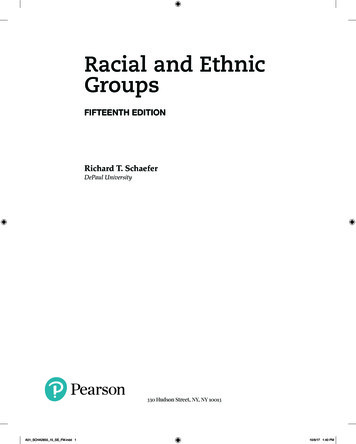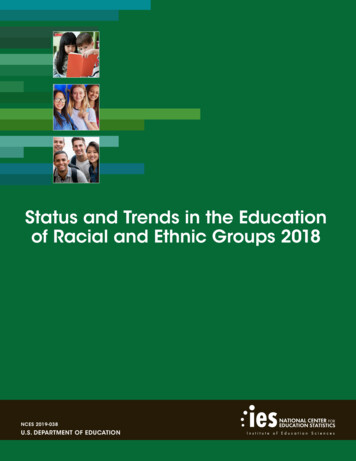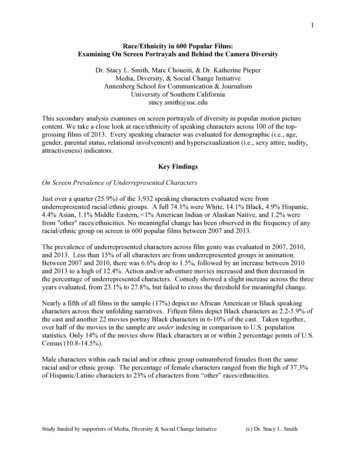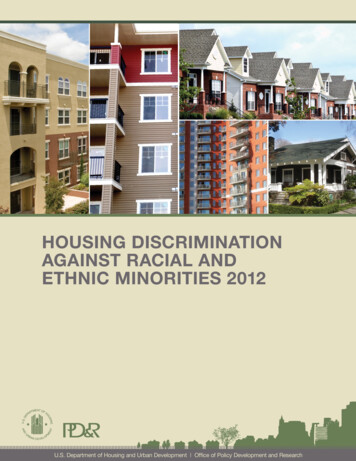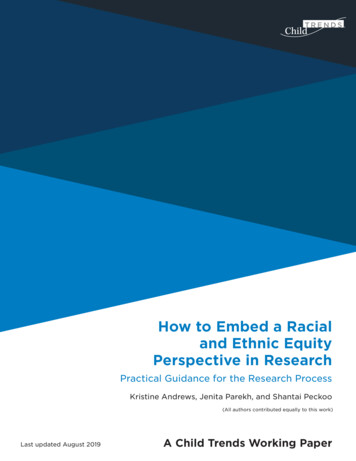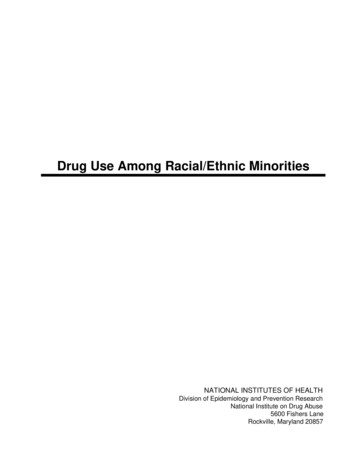
Transcription
Drug Use Among Racial/Ethnic MinoritiesNATIONAL INSTITUTES OF HEALTHDivision of Epidemiology and Prevention ResearchNational Institute on Drug Abuse5600 Fishers LaneRockville, Maryland 20857
ACKNOWLEDGMENTSThis publication was produced for the National Institutes of Health, National Institute onDrug Abuse (NIDA), Division of Epidemiology and Prevention Research, by CSR, Incorporated,Washington, D.C., under Contract No. N01DA-6-5053. The report was developed by the projectofficer, Andrea Kopstein, of NIDA, and the co-project officer, Leslie Cooper, Ph.D. Significantcontributors to the report include Diane Deitz, Ph.D., Lisa Gibson, M.P.M., Thomas Nephew,M.P.P.S., Faith Samples, Ph.D., Lorna Sanchez, William Scarbrough, Ph.D., and Fred Stinson,Ph.D., of CSR, Incorporated, under contract to NIDA.PUBLIC DOMAIN NOTICEAll material appearing in this volume is in the public domain and may be reproduced orcopied without permission from NIDA. Citation of the source is appreciated.National Institute on Drug AbuseNIH Publication No. 98-3888Printed 1995Revised September 1998
Table of ContentsACKNOWLEDGMENTSLIST OF TABLES .vLIST OF FIGURES. ix1. INTRODUCTION.1Definition of Race and Ethnicity.2American Indians/Alaska Natives .4Asian/Pacific Islanders.4African Americans.5Hispanics.5Overview of Drug Use and Drug-Related Problems.6Methods .6Data Sources .7Census of the United States .7National Household Survey on Drug Abuse .7Partnership Attitude Tracking Survey.8Monitoring the Future Study .8National Longitudinal Survey of Youth .9Dropout Statistics. 10American Indian/Alaska Native Statistics. 10Youth Risk Behavior Survey . 10Drug Abuse Warning Network. 11AIDS Surveillance Data. 11Drug Use Forecasting System. 12Organization of the Report . 132. POPULATION STATISTICS FOR RACIAL/ETHNIC MINORITIESIN THE UNITED STATES.15Population Statistics. 15Summary . 163. GENERAL POPULATION. 21Prevalence of Drug Use. 21Attitudes and Perceptions. 24Summary . 274. YOUTH PREVALENCE. 41Age at First Use . 41Prevalence Trends. 42iii
Table of ContentsSecondary School Students. 42American Indians . 45Longitudinal Trends . 46Summary . 475. YOUTH DRUG USE AND RISKY BEHAVIORS . 67School Dropout Trends . 67Risk Behavior Trends . 69Summary . 696. ADVERSE HEALTH CONSEQUENCES . 81Acquired Immunodeficiency Syndrome . 81Drug-Related Emergency Room Episodes . 82Drug-Related Deaths. 85Summary . 867. DRUGS AND CRIME . 101Drug Use Among Booked Arrestees. 102Driving Under the Influence . 103Summary . 1038. SUMMARY AND FUTURE DRUG ABUSE PROGRAMAND RESEARCH NEEDS. 107BIBLIOGRAPHY . 111iv
LIST OF TABLESTable 1Estimated percentage distribution of the U.S. population, by race/ethnicity andHispanic origin, 1990–2050 . 17Table 2Weighted average poverty thresholds in 1991, 1993, 1995, and 1997by size of family . 18Table 3Poverty thresholds in 1996, by size of family and number of relatedchildren under 18 years of age (in dollars). 19Table 4Persons and families living below poverty level, according to selectedcharacteristics, race, and Hispanic origin: United States, selectedyears 1973–96 . 20Table 5NHSDA sample sizes and United States civilian noninstitutionalized populationtotals, by sex and age across race/ethnicity for ages 12and older: 1996 . 29Table 6Prevalence of use for selected drugs among persons ages 12 and olderin the United States: 1996 . 30Table 7Prevalence of past-month drug use in the United States, by ageand sex: 1996 . 31Table 8Prevalence of past-month drug use in the United States, by age, sex, andrace/ethnicity represented in percentages: 1996 . 32Table 9Prevalence of past-month drug use among Hispanics in the UnitedStates, by age and sex represented in percentages: 1995 and 1996 combined . 33Table 10 Percentage of women of childbearing age (15–44) using drugs, by age,race/ethnicity, and population density: 1996 . 34Table 11 Percentage of live-born infants’ mothers who reported smoking during pregnancy,by year and race/ethnicity, U.S. final natality statistics, 1989-1995.36Table 12 Percent of respondents who believe that selected drugs are easy to get for themselves(youth and teens) and for their children (parents), by race/ethnicity: 1993, 1995, and1996.37Table 13 Percent of respondents who associate danger/great risk with the use of selecteddrugs, by race/ethnicity: 1993, 1995, and 1996 .38Table 14 Percent of respondents who agree with selected statements concerning variousdrugs by race/ethnicity: 1993, 1995, and 1996 .39Table 15 Average age of first use of cigarettes, alcohol, and marijuana for youthages 12–17 by race/ethnicity: 1990, 1991, 1993, 1995, and 1996 .49v
List of TablesTable 16 Prevalence of lifetime, annual, 30-day, and daily use of selected drugs,by race/ethnicity for 8th, 10th, and 12th graders (percent): 1997 .50Table 17 Trends in the percentage of 12th graders who were previous-month smokers,by race/ethnicity and gender, Monitoring the Future Surveys, United States,1976–79, 1980–84, 1985–89, and 1990–94 .54Table 18 Use of selected substances in the past month and binge drinking in the past2 weeks among 12th graders and 8th graders, by sex and race/ethnicity (percent):1980–97.55Table 19 Percentage of African American and white 12th graders who reportedrecently using or not using cigarettes and other selected substances,Monitoring the Future surveys, United States, 1976–94 aggregate data .58Table 20 Prevalence of youth ages 12 and older having used alcohol, marijuana,cocaine, or crack-cocaine in lifetime or past month, by age, sex, andrace/ethnicity (percent): 1995.59Table 21 Percentage of American Indian 7th–12th graders living on reservationsreporting lifetime use of drugs during various years from 1975 through 1994.60Table 22 Percentage of American Indians and non-Indian high school seniors whohave ever tried drugs in their lifetime and in the past month: 1991–93.61Table 23 Percentage of American Indian 4th–6th graders reporting lifetime useof drugs: 1980–81, 1987–88, 1989–90, 1990–91, and 1992–94 .62Table 24 Percentage of National Longitudinal Survey of Youth cohorts admittingto use of marijuana and cocaine, by race/ethnicity and year.63Table 25 Rate, number, and distribution of status dropouts, by sex, race/ethnicity,family income, region, and metropolitan status: 1996.71Table 26 Status dropout rate for persons ages 16–24, by family income andrace/ethnicity: 1996.72Table 27 Event dropout rates for those in grades 10–12, and/or ages 15–24, by sex andrace/ethnicity, represented in percentages: selected Octobers 1972–96 .73Table 28 Reasons for dropping out of school, by sex and race/ethnicity represented inpercentages: 1992.74Table 29 High school completion rates and method of completion for persons ages 18through 22 not currently enrolled in high school, by race/ethnicity:October 1990–October 1996.75Table 30 Percentage of youth engaging in risk behaviors, by drug usersand nonusers and race/ethnicity: 1995.76vi
List of TablesTable 31 Female adult/adolescent AIDS cases, by exposure categoryand race/ethnicity, cumulative totals through December 1997.87Table 32 Male adult/adolescent AIDS cases, by exposure categoryand race/ethnicity, cumulative totals through December 1997 .88Table 33 Number of emergency department drug abuse episodes and mentions ofselected drugs per 100,000 population in the coterminous United States,by sex and age: 1994.89Table 34 Drugs mentioned most frequently by emergency rooms by sex andrace/ethnicity of patient: 1994.90Table 35 Estimated number of DAWN hospital emergency room visits, by race/ethnicityand age: 1988–94 .91Table 36 Estimated number of DAWN hospital emergency room visits with mentionof cocaine, by race/ethnicity and age: 1988–94 .92Table 37 Estimated number of DAWN hospital emergency room visits with mentionof heroin/morphine, by race/ethnicity and age: 1988–94 .93Table 38 Estimated number of DAWN hospital emergency room visits with mentionof methamphetamine/speed, by race/ethnicity and age: 1988–94.94Table 39 Estimated number of DAWN hospital emergency room visits with mentionof marijuana/hashish, by race/ethnicity and age: 1988–94.95Table 40 Percentage of DAWN hospital emergency room drug abuse episodes,by selected episode characteristics, sex, and race/ethnicity: 1994.96Table 41 Comparison of the race/ethnicity distribution for total DAWN hospital emergencyroom episodes with the race/ethnicity distribution for selected drugmentions: 1994.97Table 42 Drugs mentioned most frequently by medical examiners, by sexand race/ethnicity of decedent: 1995 .98Table 43 Prevalence of positive urinalysis tests from the Arrestee Drug AbuseMonitoring Program (formerly the Drug Use Forecasting System):1987–95.104Table 44 Percentage of people having driven a vehicle under the influence ofalcohol or illegal drugs in the past 12 months, by race, sex, and age:1995.105vii
LIST OF FIGURESFigure 1Trends in the prevalence of daily cigarette use among 12th graders, byrace/ethnicity: 1977–97 . 64Figure 2Trends in the prevalence of marijuana use in the past year among12th graders, by race/ethnicity: 1977–97 . 64Figure 3Trends in the prevalence of inhalant use in the past year among12th graders, by race/ethnicity: 1977–97 . 65Figure 4Trends in the prevalence of cocaine use in the past year among12th graders, by race/ethnicity: 1977–97 . 65Figure 5Trends in the prevalence of LSD use in the past year among12th graders, by race/ethnicity: 1977–97 .66Figure 6Status dropout rates for persons ages 16–24, by race–ethnicity:October 1972 through October 1996.79Figure 7Completion rates for persons ages 18–24 not currently enrolled in highschool or below, by race–ethnicity: October 1972 through October 1996 .79Figure 8Manner of drug-related death, by race/ethnicity, DAWN medicalexaminer data: 1995. 99ix
Chapter 1. INTRODUCTIONThe purpose of this report is to provide policymakers, researchers, and others with anunderstanding of the nature of drug use among minorities by summarizing the most current dataon this issue. The data in this report came from several large- and small-scale epidemiologicalstudies that collect and analyze data on the incidence, prevalence, morbidity, mortality, and otheradverse health consequences of drug use among racial/ethnic populations. These surveys aresponsored by several Federal agencies including, but not necessarily limited to, the U.S. Bureau ofthe Census, the Centers for Disease Control and Prevention (CDC), the Department of Education,the Department of Justice, the National Center for Health Statistics, the National Institute onDrug Abuse (NIDA), National Institute of Justice, and the Substance Abuse and Mental HealthServices Administration (SAMHSA). Information on youths’ attitudes toward drugs also isincluded from the Partnership for a Drug-Free America’s (PDFA’s) Partnership Attitude TrackingSurvey (PATS).The United States has been undergoing major demographic changes and will continue thistransformation in the coming years. By the year 2030, racial/ethnic minorities are expected toconstitute one-half of the student population kindergarten through 12th grade (EducationResearch Service 1995). In contrast, the non-Hispanic white share of the U.S. population isexpected to decrease from 74 percent in 1995 to 72 percent in 2000, 68 percent in 2010, 61 percentin 2030, and 53 percent in 2050 (U.S. Bureau of the Census 1996). Consequently, racial/ethnicminorities will require increased attention from policymakers so the Nation can understand,prevent, and address many of the social and economic problems that plague minority families andminority neighborhoods.Beginning in 1963 the President’s Advisory Commission on Narcotic and Drug Abuse, andin 1972 the National Commission on Marihuana and Drug Abuse, recognized the growing problemof drug abuse (National Commission on Marihuana and Drug Abuse 1973). Reports from bothcommissions cited the inadequacy of the data available at that time to assess the true prevalenceof drug use in our society. Knowledge regarding the epidemiology of drug abuse in the generalpopulation expanded with the establishment of NIDA in 1974; the development of the NationalHousehold Survey on Drug Abuse (NHSDA), initiated in 1971; and the Monitoring the FutureStudy, initiated in 1975. The Anti-Drug Abuse Act of 1986 and the Anti-Drug Abuse Act of 1988focused data collection efforts on special populations, including racial/ethnic groups and those indrug abuse treatment. Epidemiologic data about alcohol and other drug abuse among minoritieshas slowly been emerging for both youth and adults, but more attention is needed to adequatelyunderstand the extent of the problem for these populations.Research has shown persons at high risk for drug abuse often are those whose lives aremarked by poverty, illiteracy, malnutrition, and other unhealthy environmental conditions. It hasbeen estimated from the NHSDA that the prevalence of drug use generally is higher in urbanareas than in suburban or rural areas. Because minorities, particularly African Americans andHispanics, often are concentrated in central city areas, they may be more at risk for drug abuseand, ultimately, more at risk for associated negative social and health consequences. Given thesefindings, this report aims to compile published data on the subject and to discuss some of theimplications of these findings.1
IntroductionDEFINITION OF RACE AND ETHNICITYCurrent definitions of race and ethnicity are under increasing scrutiny. Many scientistsbelieve race is a mere “social construct,” and the boundaries between different races depend on theclassifier’s own cultural norms (Begley 1995). Similarly, the definition of race varies from survey tosurvey; however, many national-level data collection systems follow Census Bureau standards.The Census Bureau collects and publishes racial statistics as outlined in Statistical PolicyDirective No. 15, issued by the Office of Management and Budget (OMB) (U.S. Department ofCommerce 1978). According to that directive, the primary racial categories are AmericanIndian/Alaskan Native, Asian/Pacific Islander, black, and white. The directive identifies Hispanicorigin as an ethnicity, which is defined as the nationality group or country of birth of a person or aperson’s parents or ancestors before arrival in the United States. Persons of Hispanic origin maybe of any race. The definitions for race and for Hispanic ethnicity, as specified under Directive No.15, are as follows: American Indian/Alaskan Native—a person having origins in any of the original peoples ofNorth America who maintains cultural identification through tribal affiliations or communityrecognition; Asian/Pacific Islander—a person having origins in any of the original peoples of the Far East,Southeast Asia, the Indian subcontinent, or the Pacific Islands; Black—a person having origins in any of the racial groups of Africa; Hispanic—a person of Mexican, Puerto Rican, Cuban, Central or South American, or otherSpanish culture or origin, regardless of race; and White—a person having origins in any of the original peoples of Europe, North Africa, or theMiddle East.Particularly since the 1990 Census, these classification standards have come underincreasing criticism from those who believe the above categories fail to reflect the growingdiversity of our Nation’s population. During the 1980’s, immigration to the United States fromMexico, Central and South America, the Caribbean, and Asia reached historic proportions. Inaddition, as a result of the increase in interracial marriages, the number of persons born of mixedrace or ethnicity has grown. Directive 15 also has been criticized as failing to be scientific, and hasbeen the basis of a major lawsuit. In response to these and other criticisms, OMB announced inJune 1993 that it would undertake a review of the current classifications for data on race andethnicity.OMB established the Interagency Committee for the Review of the Racial and EthnicStandards in March 1994 to facilitate the participation of Federal agencies in the review process.The Interagency Committee’s 30 members were employees of the agencies who represent thediverse Federal needs for data on race and ethnicity, including statutory requirements for suchdata. Two major elements of the process were (1) public comment on present definitions and (2)research and testing related to an assessment of the possible effects of recommended changesregarding the quality and usefulness of the resulting data. The goal of the Committee’s work wasto produce definitions resulting in consistent, publicly accepted data on race and ethnicity to meetthe needs of the Federal Government and the public, while recognizing the diversity of thepopulation and respecting the individual’s dignity.2
IntroductionThis section details the Interagency Committee’s recommendations for changes in racialand ethnic categories for use by the U.S. Government. The Census Bureau is expected toincorporate these changes into the questions for the 2000 Census “practice run” in 1998.The minimum categories for data on race and ethnicity for Federal statistics and programadministrative reporting are defined as follows: American Indian or Alaskan Native—a person having origins in any of the original peoples ofNorth and South America (including Central America) who maintains cultural identificationthrough tribal affiliation or community recognition. Asian or Pacific Islander—a person having origins in any of the original peoples of the FarEast, Southeast Asia, the Indian subcontinent, or the Pacific Islands. These areas include, forexample, China, India, Japan, Korea, the Philippine Islands, Hawaii, and Samoa. Black or African American—a person having origins in any of the black racial groups of Africa. Hispanic—a person of Mexican, Puerto Rican, Cuban, Central or South American, or otherSpanish culture or origin, regardless of race. White—a person having origins in any of the original peoples of Europe, North Africa, or theMiddle East.The recommended changes for data collection also include an emphasis on data quality.When race and ethnicity data are collected separately, ethnicity data should be collected first. Inaddition, the minimum designations for ethnicity and race are as follows: Ethnicity Hispanic Origin, and Not of Hispanic Origin; and Race American Indian or Alaskan Native, Asian or Pacific Islander, Black or African American, and White.In addition, persons can, but are not required to, report more than one race. A minimum ofone additional racial category, designated “more than one race” has been recommended to reportthe aggregate number of multiple race responses. Greater detail of multiple race responses also isencouraged. For example, terms such as “Haitian” or “Negro” can be used in addition to “Black”and “African American,” while terms such as “Latino” or “Spanish origin” can be used in additionto “Hispanic.” This classification system will allow for the collection of data on “Hispanic and oneor more races” and “More than one race.”For the full text of the Committee’s analysis and recommendations, readers should refer toAppendix 2 of the Federal Register for July 9, 1997. These recommendations, designed to provideminimum standards for Federal data on race and ethnicity, concern options for reporting byrespondents, formats of questions, and several aspects of specific categories, including possibleadditions, revised terminology, and changes in definition.3
IntroductionThe following population statistics and information pertaining to drug use among membersof each race/ethnicity are summarized from existing reports and provide a context for the datadiscussed later in this report. A summary of Asian/Pacific Islander information is provided forcompleteness only; data available on drug use among this population are very limited.American Indians/Alaskan NativesAt the turn of the century, 220,000 American Indians/Alaskan Natives lived in the UnitedStates; the 1990 census indicated this population had grown to approximately 2 million, which istwo times the 1970 count (U.S. Bureau of the Census 1991). This exceptional increase is due toimproved health care for all ages, an accelerated birth rate, and a greater willingness to reportNative American ancestry. In 1994 the birth rate among American Indians/Alaskan Natives was13 percent higher than that of the country at large (U.S. Bureau of the Census 1997).In 1993 there were 341 federally recognized tribes (Hirschfelder and Montano 1993, inMoran 1995). By 1997 there were 558 federally recognized tribes (U.S. Bureau of Indian Affairs1997). The median age of the American Indian/Alaskan Native population was 24.2 years in 1990,compared with 34.4 years for U.S. whites (Indian Health Service 1993). This could account for thesignificant differences in drug use prevalence rates that exist between the two groups. Sixty-twopercent of American Indians n
National Institute on Drug Abuse 5600 Fishers Lane Rockville, Maryland 20857. ACKNOWLEDGMENTS This publication was produced for the National Institutes of Health, National Institute on Drug Abuse (NIDA), Division of Epidemiology and Prevention Research, by CSR, Incorporated,



